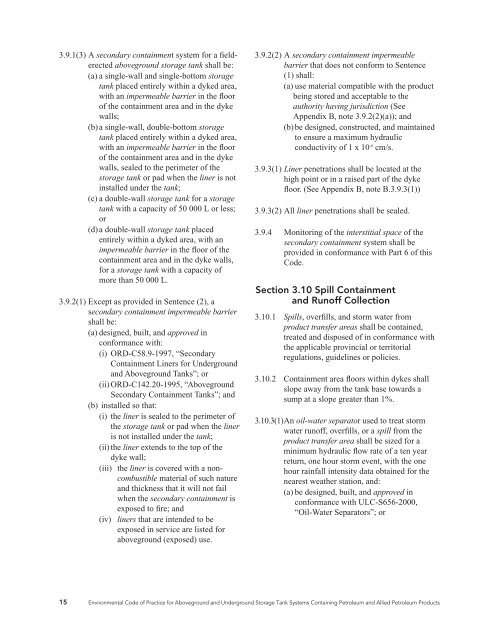Environmental Code of Practice for Aboveground and ... - CCME
Environmental Code of Practice for Aboveground and ... - CCME
Environmental Code of Practice for Aboveground and ... - CCME
Create successful ePaper yourself
Turn your PDF publications into a flip-book with our unique Google optimized e-Paper software.
3.9.1(3) A secondary containment system <strong>for</strong> a fielderected<br />
aboveground storage tank shall be:<br />
(a) a single-wall <strong>and</strong> single-bottom storage<br />
tank placed entirely within a dyked area,<br />
with an impermeable barrier in the floor<br />
<strong>of</strong> the containment area <strong>and</strong> in the dyke<br />
walls;<br />
(b) a single-wall, double-bottom storage<br />
tank placed entirely within a dyked area,<br />
with an impermeable barrier in the floor<br />
<strong>of</strong> the containment area <strong>and</strong> in the dyke<br />
walls, sealed to the perimeter <strong>of</strong> the<br />
storage tank or pad when the liner is not<br />
installed under the tank;<br />
(c) a double-wall storage tank <strong>for</strong> a storage<br />
tank with a capacity <strong>of</strong> 50 000 L or less;<br />
or<br />
(d) a double-wall storage tank placed<br />
entirely within a dyked area, with an<br />
impermeable barrier in the floor <strong>of</strong> the<br />
containment area <strong>and</strong> in the dyke walls,<br />
<strong>for</strong> a storage tank with a capacity <strong>of</strong><br />
more than 50 000 L.<br />
3.9.2(1) Except as provided in Sentence (2), a<br />
secondary containment impermeable barrier<br />
shall be:<br />
(a) designed, built, <strong>and</strong> approved in<br />
con<strong>for</strong>mance with:<br />
(i) ORD-C58.9-1997, “Secondary<br />
Containment Liners <strong>for</strong> Underground<br />
<strong>and</strong> <strong>Aboveground</strong> Tanks”; or<br />
(ii) ORD-C142.20-1995, “<strong>Aboveground</strong><br />
Secondary Containment Tanks”; <strong>and</strong><br />
(b) installed so that:<br />
(i) the liner is sealed to the perimeter <strong>of</strong><br />
the storage tank or pad when the liner<br />
is not installed under the tank;<br />
(ii) the liner extends to the top <strong>of</strong> the<br />
dyke wall;<br />
(iii) the liner is covered with a noncombustible<br />
material <strong>of</strong> such nature<br />
<strong>and</strong> thickness that it will not fail<br />
when the secondary containment is<br />
exposed to fire; <strong>and</strong><br />
(iv) liners that are intended to be<br />
exposed in service are listed <strong>for</strong><br />
aboveground (exposed) use.<br />
3.9.2(2) A secondary containment impermeable<br />
barrier that does not con<strong>for</strong>m to Sentence<br />
(1) shall:<br />
(a) use material compatible with the product<br />
being stored <strong>and</strong> acceptable to the<br />
authority having jurisdiction (See<br />
Appendix B, note 3.9.2(2)(a)); <strong>and</strong><br />
(b) be designed, constructed, <strong>and</strong> maintained<br />
to ensure a maximum hydraulic<br />
conductivity <strong>of</strong> 1 x 10 -6 cm/s.<br />
3.9.3(1) Liner penetrations shall be located at the<br />
high point or in a raised part <strong>of</strong> the dyke<br />
floor. (See Appendix B, note B.3.9.3(1))<br />
3.9.3(2) All liner penetrations shall be sealed.<br />
3.9.4 Monitoring <strong>of</strong> the interstitial space <strong>of</strong> the<br />
secondary containment system shall be<br />
provided in con<strong>for</strong>mance with Part 6 <strong>of</strong> this<br />
<strong>Code</strong>.<br />
Section 3.10 Spill Containment<br />
<strong>and</strong> Run<strong>of</strong>f Collection<br />
3.10.1 Spills, overfills, <strong>and</strong> storm water from<br />
product transfer areas shall be contained,<br />
treated <strong>and</strong> disposed <strong>of</strong> in con<strong>for</strong>mance with<br />
the applicable provincial or territorial<br />
regulations, guidelines or policies.<br />
3.10.2 Containment area floors within dykes shall<br />
slope away from the tank base towards a<br />
sump at a slope greater than 1%.<br />
3.10.3(1)An oil-water separator used to treat storm<br />
water run<strong>of</strong>f, overfills, or a spill from the<br />
product transfer area shall be sized <strong>for</strong> a<br />
minimum hydraulic flow rate <strong>of</strong> a ten year<br />
return, one hour storm event, with the one<br />
hour rainfall intensity data obtained <strong>for</strong> the<br />
nearest weather station, <strong>and</strong>:<br />
(a) be designed, built, <strong>and</strong> approved in<br />
con<strong>for</strong>mance with ULC-S656-2000,<br />
“Oil-Water Separators”; or<br />
15 <strong>Environmental</strong> <strong>Code</strong> <strong>of</strong> <strong>Practice</strong> <strong>for</strong> <strong>Aboveground</strong> <strong>and</strong> Underground Storage Tank Systems Containing Petroleum <strong>and</strong> Allied Petroleum Products

















